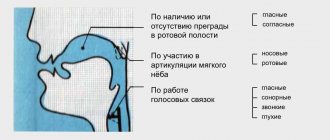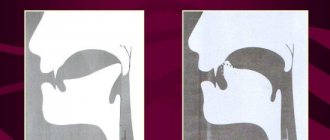- home
- Directories
- Handbook of Russian for elementary school
- Sounds and letters
In spoken language, words are made up of sounds . In written language, words are made up of letters . We pronounce and hear sounds, and we write and see letters (when we read). In writing, sounds are represented by letters.
We also use letters to indicate sounds, but we put them in square brackets. This is a phonetic notation of letters.
For example: sound [m], letter - “em”
The phonetic notation of letters is a transcription . It helps us understand how we speak, reflects the living sound of speech, and teaches us how to pronounce words correctly.
When preparing a transcription, consider:
- it is formatted in square brackets
- each sound corresponds to one sign
- capital letter is not used
- Words must be stressed
- the softness of a consonant is indicated by the symbol [ ' ] - polka - [pol' ka], leaf - [l' source]
- the longitude of a sound is indicated by the symbol [ ¯ ] - it is used when two letters make one sound: quarrel - [quarrel]
Stress placement is very important for correct phonetic notation. Stress, its features and rules of placement in the Russian language are studied by the science of accentology .
There are sounds: vowels and consonants .
The letters are:
- letters denoting vowel sounds (a, o, u and others)
- letters denoting consonants (m, r, k, b and others)
- letters that do not represent sounds (ъ, ь)
The Russian language has more sounds than letters.
To perform phonetic analysis means to characterize all the sounds that make up the word to be analyzed.
Share with friends on social networks:
Phonetic analysis - what is it?
The word “phonetics” came into Russian speech from the Greek language. Translated it means “sound”.
What does phonetics study?
The science of phonetics studies the sound composition of a language, the history of the origin of different sounds, as well as the characteristics of each sound.
Phonetics examines in detail which human speech organs are involved in the formation of a particular sound: lips, tongue, teeth, palate.
For example, we already know that sounds are divided into vowels and consonants. The voice takes part in the formation of vowels, and the voice and noise or only noise takes part in the formation of consonants. In total, there are 6 vowels and 36 consonants in the Russian language. Consonant sounds are divided into two groups.
Group 1 “Hard and soft consonants”
Group 2 “Voiced and voiceless consonants”
Sounds combine with each other to form syllables and words. With the help of sounds we distinguish words in speech. You can change just one sound in a word, and its meaning completely changes:
- cat (animal) – code (cipher);
- poppy (flower) – magician (wizard);
- port (parking place for marine transport) – court (tennis ground).
Phonetics also considers what position sounds are in: strong or weak. The position for a sound is considered strong if it is pronounced clearly.
A strong position for a vowel is when the sound is under stress: jam, guests, November. All unstressed sounds in these and other words occupy a weak position.
For a consonant sound, the position is strong if vowel sounds are located nearby: hammers, blizzard, leg, roads. Each consonant is pronounced clearly, there is no doubt about the spelling.
A consonant is in a weak position if:
They check the spelling, changing the word so that after a weak consonant there is a vowel sound: hammer - hammer to i, friend - from a friend , calico - from calico , mistake - mistakes b ochka, spoon - spoons . If this method is not suitable, then we remember the spelling of the word and check it in a spelling dictionary.
Sounds in writing are displayed as letters.
What is the alphabet?
Do you hear the song coming from the island? Let's listen to her. What are the residents singing about?
How interesting this is. It's time to explore the surroundings. And here is a map of the island.
This map is not easy
This is the Russian ALPHABET!
He will put the letters in their places.
And order reigns in it.
Everyone needs to know the alphabet
Study together at school!
What an amazing island! Perhaps we need to learn the entire alphabet; knowing the letters will help us develop the ability to read.
Exercise
Look at the picture above, remember or count: how many letters are in the Russian alphabet?
Answer: 33 letters.
Let's walk around the island. Here it is written how the Russian alphabet originated.
How interesting! But we need to ask residents to tell us about this story in even more detail. Someone is coming towards us, it looks like the letter A!
Now guys, listen to the story associated with the appearance of the alphabet, the oldest resident of the city, Az, will tell it to us.
The Tale of the Alphabet
Great learned men appeared on Russian soil who wanted to make our state glorious and powerful. These were the monk brothers Cyril and Methodius. They chose a noble path - to make Russian people smart, to teach everyone to read and write. And before them there was no single order of letters. Taking the Greek alphabet as a basis, the brothers did a great job.
They were able to arrange all the letters. This is how the Glagolitic alphabet appeared - the first alphabet, derived from the word “verb” - to speak.
And then they made it even simpler and called it Cyrillic. 43 letters are included in this alphabet. And each letter was highlighted and given its name. The first letters were named Az, Buki - this is how the word ABC appeared.
This alphabet has changed for several centuries. Has gone through many reforms. And now we have a completely new, but very convenient alphabet that every child should know.
Glory to the alphabet! Thank you, Cyril and Methodius, for your invaluable gift to people.
Did you know that all books used to be written by hand! They were written by monks, carefully writing each letter. Such a book took a year to write, and sometimes even longer. We would not even be able to distinguish a written book from a printed one, because it was written in compliance with all the rules of style. The creators of books were called chroniclers. They were extraordinarily talented and hardworking. The first creators of handwritten books had to show a lot of strength and patience.
But soon Ivan Fedorov became the founder of book printing. Printed books appeared. They were created for training. Later, secular books began to be published, which were purchased by noble and wealthy people. Much time has passed since then, books have become an everyday item and have become a part of our lives.
Currently, all letters have two styles: printed and capital. Capital letters of the Russian alphabet are necessary for fast writing. Block letters are used in books and other publications. At the same time, teaching expressive reading occurs with the help of printed letters.
In first grade, you will develop the ability to read and write capital letters.
This skill is very important for every person. After all, writing block letters takes a long time and is completely inconvenient. Having mastered a wonderful way of writing quickly, you will cope with rewriting any text much faster. This path is difficult and will require diligence and effort. That is why every person develops his unique handwriting.
The order of phonetic parsing of a word
The word is often pronounced completely differently from how it is written. For example: we write “milk”, “chocolate”, but pronounce “malako”, “jackalat”. Phonetic analysis of a word, in other words, sound analysis, helps to understand the difference between the sounds we pronounce and the letters we write. The sound recording of a word is made using transcription.
Let's listen to Academician Sound Expert on how to do this work correctly.
Examples from Academician Sound Scientist:
It is important to correctly write the word in transcription:
- vowels and consonants in a strong position are written as they are heard;
- emphasis must be placed;
- sounds in a weak position are recorded as they are pronounced;
- the softness of consonants is indicated by a comma to the right above the letter.
§236. Pronunciation of some consonants
1. The consonant [g] in literary pronunciation is explosive, instant sounding, and when deafened, is pronounced as [k]: sn[k], bere[k]. g in its place , conventionally designated [ h ], does not correspond to the norm: [ h]ulya ́t, sapo[ h]i ́. The exception is the word God, at the end of which there is an [x].
2. Instead of h in the words of course, boring, scrambled eggs, trifling, birdhouse, bachelorette party, laundry, rag, rag-picker, in female patronymics ending in - and chna ( Nikitichna, Kuzminichna, Ilyinichna , etc.), as well as in the words that, in order, nothing is pronounced [sh] .
3. In the words man, defector in the place of the combination zhch , in the form of the comparative degree of adverbs tougher, harsher (and biting ) in the place stch , and also in the place of the combinations zch and sch it is pronounced [sch]: loader, customer, carver, subscriber, sandstone , happy, happiness, account, electronic counting, counter, self-financing, count, etc.
4. When several consonants accumulate in some combinations, one of them is not pronounced:
a) in combination stn is not pronounced [t]: ucha ́[s'n']ik, ve ́[s']nik, che ́[sn]y, me ́[sn]y, famous ́[sn]y, nena ́[sn]y, I ́ro[s]y;
b) in the combination zdn is not pronounced [d]: po ́[zn]o, pra ́[zn]ik, nae ́[zn]ik, but in the word abyss it is recommended to leave a weak sound [d];
c) in the combination stl, [t] is not pronounced scha [ s'l ']i ́vyy, envious ́[s'l']ivy, so ́ve[s'l']ivy; in the words bony and postlat [t] is preserved;
d) in combination stl, [t] is not pronounced in this case, a double consonant [ss] is formed: maximali ́[ss]kiy, turi ́[ss]kiy, rasi ́[ss]kiy.
5. In some words, with the accumulation of consonant sounds stk , zdk, ntk, ndk, [t] is not allowed daughter-in-law, trip, agenda, typist, bulky, laboratory assistant, student, patient, Irish, tartan, but: cloth shotla [ nc ] A.
6. Hard consonants before soft consonants can be softened:
a) it is necessarily softened before soft z and s: pe ́[n's']iya, prete ́[n'z']iya, rece ́[n'z']iya, face ́[n'z'] and I;
b) in combinations tv , dv can be softened t and d : Thursday, Tver, hard [t'v'] and [tv']; door, two, move [d'v] and [dv'];
c) in combinations of sound and sv z and can be softened : beast, ring [z'v'] and [zv']; light, candle, witness, holy [s'v] and [sv'], as well as in the word snake [z'm'] and [zm'];
d) n before soft t i d softens: ba[n't']ik, vi[n't']ik, zo[n't']ik, ve[n't']il, a[n' t']ichny, ko[n't']text, remo[n't']irovat, ba[n'd']it, I[n'd']iya, stip[n'd']iya, zo[n'd']irovat, i[n'd']ivid, ka[n'd']idat, blo[n'd']in.
↑ Contents ↑
Word color scheme
Guys, do you know that sounds have their own color? Our guest, the fabulous artist Pencil, will tell you more about this.
Now the word can be written in the form of colored squares:
Guys, consonant sounds are pronounced together with the vowels that follow them: porridge, Pinocchio. This phenomenon is called sound fusion. Let's find out how Pencil suggests representing consonant-vowel merging in a color scheme.
The black dash on top is an accent mark. It is placed above the vowel in a strong position. The color scheme uses another sign (straight vertical black line): dividing the word into syllables.
And here is how iotized letters, which give two sounds, are written in the color scheme:
The sound [th'] is consonant and soft. Therefore, it is indicated in green in the diagram. It merges with the vowel [o], in the scheme of the word these sounds divide one rectangle into two parts.
§237. Pronunciation of individual grammatical forms
Some grammatical forms of verbs, nouns, and adjectives are characterized by special rules for the pronunciation of sounds in suffixes and endings.
1. In verbs with the particle -с I in the indefinite form and in the third person singular and plural, at the junction of the ending and the particle, [ts] is pronounced: meet, meet meet ́ti [ts], mark, mark – mark ́ti [ts], to check in - mark ́[ts], to say goodbye - farewell ́[ts].
In the form of the imperative mood, at the place of the combination -t'sya , two soft sounds [t's''] sound: mark - mark [t's''], meet - wind ́ [t's''].
2. At the endings of the genitive case of the masculine and neuter forms of adjectives, numerals, pronouns -о go/-е in place of g it is pronounced [в]: big house (lake) – big ́[вь], blue flag (sea) – с ́не [v]. The same rule applies to the words today - se[v]o ́, total - ito [v]o ́.
| Note. In surnames ending in -a go ( Shembinago , Zhivago ), the sound [g] is pronounced. |
3. Graphic abbreviations found in the text, for example, initials with a surname, as well as abbreviations such as l (liter), m (meter), kg (kilogram), ha (hectare), p/y (“mailbox”), t .d. (etc.), with (page), etc. in reading are “deciphered”, i.e. “unfold” into full words. Graphic abbreviations exist only in written speech for visual perception only, and their literal reading is perceived either as a speech error or as irony, appropriate only in special situations.
↑ Contents ↑
Number of letters and sounds in words
Guys, using the color scheme of the word, it will not be difficult for you to characterize each sound, count the number of letters and sounds.
You already know from previous lessons that words may have a discrepancy in the number of sounds and letters. Let's consider in what cases this happens.
- If the word contains a soft sign b: mouse, finger. Let's write down the transcriptions of words, count the number of letters and sounds in the words: [mouse] (4 letters, 3 sounds), [pal'ch'ik] (7 letters, 6 sounds). There are fewer sounds than letters.
- If a word contains iotated letters, which are formed by two sounds: a consonant [th] and vowels: [a], [u], [o] [e]. Example: fir tree [y'olka] (4 letters, 5 sounds), south [y'uk] (2 letters, 3 sounds), berry [y'agada] (5 letters, 6 sounds). These examples have more sounds than letters.
Apart from b, the letter b has no sound. But a hard sign does not change the number of sounds in words. It is followed by iotated vowels, which have 2 sounds, so the number of letters and sounds in words with Ъ can coincide: entrance [pady'est] (7 letters, 7 sounds), departure [aty'est] (6 letters, 6 sounds) .
Guys, Pencil's friend, the fabulous inventor Samodelkin, offers to practice completing tasks related to the topic of our lesson.
§235. Pronunciation of vowel sounds
The main feature of Russian literary pronunciation in the area of vowels is their different sound in stressed and unstressed syllables with the same spelling. In unstressed syllables, vowels are reduced . There are two types of reduction - quantitative (when the length and strength of the sound decreases) and qualitative (when the sound itself changes in an unstressed position). Vowels in the 1st pre-stressed syllable undergo less reduction, and more in all other syllables. The vowels [a], [o], [e] are subject to both quantitative and qualitative reduction in unstressed syllables; The vowels [i], [ы], [у] do not change their quality in unstressed syllables, but partially lose their duration.
1. Vowels in the 1st pre-stressed syllable:
a) after hard consonants in place of o and a a weakened sound [a] is pronounced: in [a] dá, n[a] gá, M[a]skva ́, s[a]dy ́, z[a]bo ́r; after the hard hissing zh and sh, in place of a and o , a weakened sound [a] is also pronounced: zh[a]ra ́, zh[a]ngler, sh[a]gi ́, sh[a]fer.
| Note 1. After hard sizzling f, w and after ts before soft consonants a sound like [s] with an overtone [uh], conventionally designated [ee]: and[ee]lét, to sozh[ye]lénuyu, w[ye]kéT, in plural forms of words horse:Losh[ye]déth, los[y]dyám etc.. in the forms of indirect cases of numerals on -twenty: twenty[ye]tí, thirty[ye]tí etc.; in rare cases, sound [ee] pronounced on the spot A in position before hard consonants: LOL[ee]but́th. w[ye]media ́n. Note 2. Unstressed [o] is pronounced in conjunctions but and what, and is also allowed in some foreign words, for example: b[o]á, b[o]mónd. rococo ́. J[o]re ́c. Note 3. Preservation of o in unstressed syllables is a feature of regional pronunciation, therefore the pronunciation is M[ o]skva ́ , p[o]ku ́ pka , p[o]e ́ dem , v[o]zi ́ tъ . v[o]kza ́ l does not correspond to the norm ; |
b) after the hard hissing w, sh and c in place of e a reduced sound like [s] with an overtone [e] is conventionally designated [ые]: w[ ые ]na ́, sh[ye]pta ́t, ts[ye] lu y;
c) after soft consonants in place of the letters i and e, as well as after soft hissing ch and sch in place a, a weakened sound [i] with an overtone [e] is pronounced, conventionally designated [ie]: m[ ie ]no ́y, R[ ie]za ́n, m[ie]sti ́, h[ie]sy ́, sh[ie]di ́t , as well as in the plural forms of the word area: area [ie]de ́y, area[ie]dya ́m and t .d.;
d) in place of i and e at the beginning of the word, the sound [i] with the overtone [e], denoted [ie] in combination with the preceding [th]: [yie] zda ́, [yie]nta ́r, [yie]ytso ́ .
| Note. Preservation of [a] in an unstressed syllable after soft consonants is a feature of regional pronunciation, therefore the pronunciation [v'a]za ́ t , [p'a]bi ́ na, h[a]sy ́ , [ya]ytso ́ , [ya ] to move does not correspond to the norm. |
2. Vowels in other unstressed syllables:
a) at the absolute beginning of a word, in place of the letters a and o , a weakened sound is always pronounced : [a]rbu ́z: [a]kno ́, [a]car ́l , [a]tclination ́nie;
b) after hard consonants in unstressed syllables, except for the 1st pre-stressed syllable, in place of a and o a reduced sound is pronounced, average in sound between [a] and [ы], short in duration, designated conventionally [ъ]: g[ ъ ] lova ́, k[ъ]randa ́sh, I ́bl[ъ]к[ъ];
c) after soft consonants in unstressed syllables, except for the 1st pre-stressed syllable, in place of a/ya and e, a reduced one is pronounced, average in sound between [i] and [e], short in duration, designated conventionally [b]: [p' b]tacho ́k, [l'l]soru ́b, you ́[n'j]su, b[b]love ́k.
3. The vowel and at the beginning of the root after a prefix or preposition ending in hard consonants is pronounced as [s]: from the institute - i[ zy ]institute, with Igor - [sy]gor; maintaining [and] and softening the consonant before it is a regional feature of pronunciation and does not correspond to the norm .
4. Stressed vowel sounds in place of e and e . Difficulties arise in the pronunciation of a number of words due to the indistinguishability of the letters e and e in printed text, because only the letter e (except for educational literature for primary schoolchildren and foreign students). This situation leads to a distortion of not only the graphic, but also the phonetic appearance of the word, and causes frequent pronunciation errors. Therefore, it is recommended to remember two sets of words:
a) with the letter e, in the place of which it sounds [e]: scam, spineless, bluff, being, icy conditions, firebrand, grenadier, stout, life, foreign, procession (but godfather ), fishing line, non-existence, perplexed, unappreciated, guardianship, sedentary ( settled life ), successor, assignee, surveillance, modern, yoke, barley, etc.;
b) with the letter e, in the place of which it sounds [o]: hopeless, veder, engraver, bile (acceptable bile ), bile (permissible bile ), mockery, traveling salesman, priest (but priest ), maneuvers, mercenary, convicted, brought in , translated, brought, sturgeon, fable, laid down, brought, brought, obscene, scrupulous, belt, smart, tesha, fur (coarse-haired), lye, etc.
In some pairs of words, different meanings are accompanied by different sounds of the stressed vowel [o] or [e]: expired (term) - expired (in blood), catechumen (screams like a catechumen) - catechumen (decree), perfect (singing) - perfect (opening) .
↑ Contents ↑
How to distinguish between sounds and letters?
It is easy to distinguish between these concepts. We write down letters, draw them, see them. They look like this: A, e, p, U, M, b. Letters are needed to translate spoken language into written language. We speak, sing, and hear sounds. They are written in square brackets: [p] [o] [l]. This recording is called transcription.
Are the number of sounds and letters the same in the Russian language?
The Russian language has 33 letters and 42 sounds.
There are much more sounds, because not every sound corresponds to a letter. The same letter can convey different sounds. Yes, the letter r
in the words
blow
and
blow
defines different sounds: hard
[r]
and soft
[r'].
On what basis are speech sounds divided?
Speech sounds are divided into vowels and consonants according to the degree of use of voice in them. When forming vowel sounds, air passes through the mouth freely. The oral cavity opens wide. Only the voice is heard.
When pronouncing consonant sounds, the air in the mouth encounters obstacles: tongue, palate, teeth, lips. For example, to pronounce [b], [p], you need to clench your lips more closely, and the sounds [v], [f] are pronounced through the gap between the teeth and lips. Every consonant sound has noise.
§238. Peculiarities of pronunciation of Russian names and patronymics
The combination of first name and patronymic is used in various situations, both in written and oral speech: in official decrees on awards, appointments, orders, lists, for example, on personnel records, the composition of production and educational groups, in business and private correspondence, in circulation to the interlocutor, in introducing and naming third parties.
In an environment of official, business communication between people, especially in the work of a teacher, translator, editor, lawyer, businessman, government or commercial employee, there is a need to address people by name and patronymic. Many Russian names and patronymics have pronunciation options that it is advisable to take into account in a given communication situation. So, when meeting a person, when introducing a person for the first time, a distinct, clear pronunciation that is close to the written form is recommended.
In all other cases, incomplete, contracted forms of pronunciation of names and patronymics, which have historically developed in the practice of literary oral speech, are acceptable.
1. Patronymics formed from male names starting with -i ( Vasily , Anatoly, Arkady, Grigory, Yuri, Evgeniy, Valery, Gennady ) end in the combinations -evich , -evna with a preceding separator ь : Vasilevich , Vasilevna ; Grigor'evich , Grigor'evna . _ When pronouncing female patronymics, these combinations are clearly preserved: Vasil evna , Anatoly evna , Grigory evna , etc. In male patronymics, full and contracted variants are allowed: Vasya ́[l' jв']ich and Vasily[l'ich], Anato ́[l' jьv']ich and Anato ́[l'ich], Grigo ́[р' jьв ']ich and Grigo ́[r'ich] , etc.
2. Patronymics formed from male names ending in -e y and -ay ( Aleksey, Andrey, Korney, Matvey, Sergey, Nikolay ) end in the combinations -eevich, -eevna, -aevich, -aevna: Alekseevich, Alekseevna, Nikolaevich, Nikolaevna . In their pronunciation, the literary norm allows both full and contracted variants: Alekse ́evich and Alekse ́[i]ch, Alekse ́evna and Alek[s'e ́]vna; Sergeevich and Serge ́[i]ch, Serge ́evna and Ser[g'e ] vna; Korneevich and Korne ́[i]ch, Korne ́evna and Kor[n'e ́ ]vna; Nikola ́evich and Nikola ́[i]ch, Nikola ́evna and Nikola ́[vn]a , etc.
3. Male patronymics ending in an unstressed combination -o vich can be pronounced both in full and contracted form: Anto ́novich and Anto ́n[y]ch, Alexa ́ndrovich and Alexa ́ndr[y]ch, Iva ́novich and Ivan ́n [y]h , etc. In female patronymics ending in the unstressed combination -o vna, full pronunciation is recommended: Alexander ovna, Boris ovna, Kirill ovna, Victor ovna, Oleg ovna , etc.
4. If the patronymic begins with and ( Ivanovich, Ignatievich, Isaevich ), then when pronounced with a name ending in a hard consonant, it turns into [s]: Pavel Ivanovich - Pavel[y]vanovich, Alexander Isaevich - Alexander[y]saevich .
5. Usually ov in female patronymics from names ending in n i m: Iva ́[n:]na, Anto ́[n:]a, Efi ́[mn]a, Maxi ́[n:]a.
6. -o in female patronymics from names ending in v is not pronounced Vyachesla ́[vn]a, Stanisla ́[vn]a.
↑ Contents ↑
Sound analysis of a word - let's figure it out
Our speech is divided into oral and written. Scientists have established that oral speech appeared before written language. People communicated using sounds. However, the awareness of maintaining written expression of information has come. This is how written speech appeared.
However, we will pay attention in this article to the oral transmission of information. The study of this section is carried out by the difficult science of phonetics. She studies speech sounds, their formation, and characteristics. This science also studies word stress, the division of words into phonetic syllables.
First, let's find out what sound analysis of a word is. Sound analysis of a word is the identification of phonemes in a word in a certain order and their description (soft - hard, voiced - voiceless, vowel - consonant).
The older group of kindergarten can already begin acquaintance with, and subsequently training in, sound analysis skills. This point is important for preschoolers also because during the study, phonemic hearing is prepared and developed. This skill gives a clear definition of phonemes; the child will not make mistakes in sounds in words, for example: HOUSE-TOM. And, when children learn to clearly distinguish words by ear, they will be able to write them down correctly. And there are also very important circumstances for analyzing sound analysis: this will subsequently be a significant circumstance when studying foreign languages.










